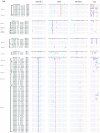Genetic Characterization of Small Ruminant Lentiviruses (SRLVs) Circulating in Naturally Infected Sheep in Central Italy
- PMID: 35458416
- PMCID: PMC9032261
- DOI: 10.3390/v14040686
Genetic Characterization of Small Ruminant Lentiviruses (SRLVs) Circulating in Naturally Infected Sheep in Central Italy
Abstract
Small ruminant lentiviruses (SRLVs) represent a very heterogeneous group of ss-RNA viruses that infect sheep and goats worldwide. They cause important, deleterious effects on animal production and limit the animal trade. SRLVs show a high genetic variability due to high mutation rate and frequent recombination events. Indeed, five genotypes (A-E) and several subtypes have been detected. The aim of this work was to genetically characterize SRLVs circulating in central Italy. On this basis, a phylogenetic study on the gag-pol genetic region of 133 sheep, collected from 19 naturally infected flocks, was conducted. In addition, to evaluate the frequency of mutation and the selective pressure on this region, a WebLogo 3 analysis was performed, and the dN/dS ratio was computed. The results showed that 26 samples out of 133 were clustered in genotype A and 106 samples belonged to genotype B, as follows: A9 (n = 8), A11 (n = 10), A24 (n = 7), B1 (n = 2), B2 (n = 59), and B3 (n = 45). No recombination events were found. Mutations were localized mainly in the VR-2 region, and the dN/dS ratio of 0.028 indicated the existence of purifying selection. Since the genetic diversity of SRLVs could make serological identification difficult, it is important to perform molecular characterization to ensure a more reliable diagnosis, to maintain flock health status, and for the application of local and national control programs.
Keywords: WebLogo analysis; dN/dS ratio; genotypes; pairwise distance; phylogenetic analysis; sheep; small ruminant lentivirus (SRLV).
Conflict of interest statement
The authors declare no conflict of interest.
Figures




References
MeSH terms
LinkOut - more resources
Full Text Sources

